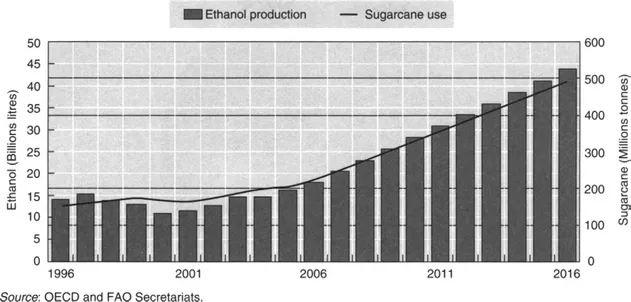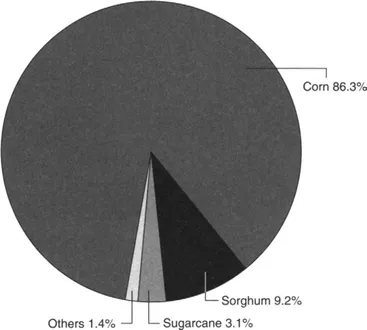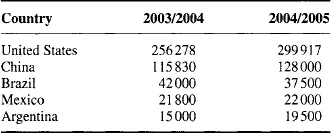
eBook - ePub
The Triazine Herbicides
Janis Mc Farland Ph.D., Orvin Burnside Ph.D., Janis Mc Farland, Ph.D., Orvin Burnside, Ph.D.
This is a test
Condividi libro
- 600 pagine
- English
- ePUB (disponibile sull'app)
- Disponibile su iOS e Android
eBook - ePub
The Triazine Herbicides
Janis Mc Farland Ph.D., Orvin Burnside Ph.D., Janis Mc Farland, Ph.D., Orvin Burnside, Ph.D.
Dettagli del libro
Anteprima del libro
Indice dei contenuti
Citazioni
Informazioni sul libro
Over the past 50 years, triazines have made a great impact on agriculture and world hunger by assisting in the development of new farming methods, providing greater farming and land use capabilities, and increasing crop yields. Triazines are registered in over 80 countries and save billions of dollars a year. The Triazine Herbicides is the one book that presents a comprehensive view of the total science and agriculture of these chemicals. With emphasis on how the chemicals are studied and developed, reviewed, and used at the agricultural level this book provides valuable insight into the benefits of triazine herbicides for sustainable agriculture.
- Presents previously unpublished information on the discovery, development and marketing of herbicides
- Includes a vital section on the origin, use, economics and fate of triazine herbicides
- Covers benefits of triazines in corn and sorghum, sugarcane, citrus, fruit and nut crops
- Establishes best management practice and environmental benefits of use in conservation tillage
Domande frequenti
Come faccio ad annullare l'abbonamento?
È semplicissimo: basta accedere alla sezione Account nelle Impostazioni e cliccare su "Annulla abbonamento". Dopo la cancellazione, l'abbonamento rimarrà attivo per il periodo rimanente già pagato. Per maggiori informazioni, clicca qui
È possibile scaricare libri? Se sì, come?
Al momento è possibile scaricare tramite l'app tutti i nostri libri ePub mobile-friendly. Anche la maggior parte dei nostri PDF è scaricabile e stiamo lavorando per rendere disponibile quanto prima il download di tutti gli altri file. Per maggiori informazioni, clicca qui
Che differenza c'è tra i piani?
Entrambi i piani ti danno accesso illimitato alla libreria e a tutte le funzionalità di Perlego. Le uniche differenze sono il prezzo e il periodo di abbonamento: con il piano annuale risparmierai circa il 30% rispetto a 12 rate con quello mensile.
Cos'è Perlego?
Perlego è un servizio di abbonamento a testi accademici, che ti permette di accedere a un'intera libreria online a un prezzo inferiore rispetto a quello che pagheresti per acquistare un singolo libro al mese. Con oltre 1 milione di testi suddivisi in più di 1.000 categorie, troverai sicuramente ciò che fa per te! Per maggiori informazioni, clicca qui.
Perlego supporta la sintesi vocale?
Cerca l'icona Sintesi vocale nel prossimo libro che leggerai per verificare se è possibile riprodurre l'audio. Questo strumento permette di leggere il testo a voce alta, evidenziandolo man mano che la lettura procede. Puoi aumentare o diminuire la velocità della sintesi vocale, oppure sospendere la riproduzione. Per maggiori informazioni, clicca qui.
The Triazine Herbicides è disponibile online in formato PDF/ePub?
Sì, puoi accedere a The Triazine Herbicides di Janis Mc Farland Ph.D., Orvin Burnside Ph.D., Janis Mc Farland, Ph.D., Orvin Burnside, Ph.D. in formato PDF e/o ePub, così come ad altri libri molto apprezzati nelle sezioni relative a Technology & Engineering e Agronomy. Scopri oltre 1 milione di libri disponibili nel nostro catalogo.
Informazioni
Argomento
Technology & EngineeringCategoria
AgronomyChapter 1
The Triazine Herbicides: A Milestone in the Development of Weed Control Technology
Homer M. LeBaron, Heber, Utah
Janis E. McFarland, Syngenta Crop Protection, Inc., Greensboro, North Carolina
Orvin C. Burnside, University of Minnesota, Minneapolis, Minnesota
Summary
This book is about the revolutionary impact of the triazines herbicides, likely the most important class of agricultural chemicals ever developed. For five decades the triazines have provided weed control in more than 50 crops around the world and have helped farmers boost yields and produce enough food to feed a rising global population. The triazine herbicides, and especially atrazine, are the most well-researched herbicides in history, with thousands of scientific studies on their safety to humans and the environment. Data from studies on the triazines have been evaluated extensively by regulatory authorities around the globe to ensure their safe use.
The first triazine was discovered in 1952 at J.R. Geigy, Ltd. in Switzerland and led to major advances in agricultural practices, basic research, safety testing, and environmental stewardship. Today one or more of the triazine herbicides is registered in more than 100 countries around the globe to provide broad-spectrum weed control in a variety of crops and noncrop sites. They provide application flexibility, are extensively used in conservation tillage programs that are integral to sustainable agriculture, and are important contributors to the management of weed biotypes that have developed resistance to other classes of herbicides.
The triazine herbicides are essential for high-yield, sustainable agriculture. They are critical to integrated pest management (IPM) and conservation tillage practices in corn and other crops – reducing the devastating environmental impact of erosion, reducing fuel costs, and retaining moisture in soil.
Changes in Agriculture and the Importance of the Triazine Herbicides
Since the 1900s, there have been significant improvements in agriculture yields, with average increases ranging from 238% to 811% for corn, cotton, sorghum, soybean, wheat, potato, and tomato (Table 1.1). From an average corn yield of 2.76 metric tonnes/ha during 1950–1959, yields of 8.87 metric tonnes/ha were obtained during 2000–2004. Since the late 1950s, the triazine herbicides have contributed significantly to improvements in yields in crops around the world.
Table 1.1
US average yield in metric tonnes/ha and percent change for 10-year periods through 1999 and for the 5-year period of 2000 through 2004a

aThis table has been modified and updated from Warren (1998) as averages from USDA National Agricultural Statistics Service data.
bThe numbers in parentheses are percentages of increases or decreases based on the average yields of the crops in the first decade given.
The historical record reveals that herbicides have replaced or reduced the use of hand weeding and cultivation for weed control, with an associated reduction in cost and an increase in yield. Today herbicides are used routinely on more than 90% of the area of most US crops, representing 87 million ha of cropland (Gianessi and Reigner, 2007).
There is a need for continued increases in yields not only to feed a growing world population, but also for greater fuel production (OECD-FAO, 2007). For example, US ethanol production, predominately based on corn, is expected to double between 2006 and 2016 (Figure 1.1). By 2016, ethanol is expected to represent a full one-third of corn production. Corn used for fuel in China is expected to increase from 3.5 million tons in 2006 to 9 million tons in 2016 (Figure 1.2). Ethanol production in Brazil is predominately based on sugarcane and is expected to increase by 145% between 2006 and 2016 (Figure 1.3).

Figure 1.1 Expansion of US ethanol production and corresponding use of corn (maize). (figure from OECD-FAO)

Figure 1.2 Expansion of Chinese ethanol production and corresponding use of corn (maize). (figure from OECD-FAO)

Figure 1.3 Expansion of Brazil ethanol production and corresponding use of sugarcane. (figure from OECD-FAO)
The first triazine was discovered in 1952 at J.R. Geigy, Ltd. in Switzerland. Today one or more of the triazine herbicides are registered in more than 100 countries around the world and are key to the production of more than 50 crops. Table 1.2 shows the major triazine herbicides today and their key uses.
Table 1.2
Major triazine herbicides and a partial listing of key uses
| Triazine herbicide | Uses |
| Ametryn | Sugarcane, corn, pineapple |
| Atrazine | Corn, sorghum, sugarcane |
| Hexazinone | Alfalfa, sugarcane, forestry, noncropland |
| Metamitron | Sugarbeet, other beet crops |
| Metribuzin | Sugarcane, potato, soybean |
| Prometon | Noncropland |
| Prometryn | Cotton, celery |
| Simazine | Corn, citrus, grape, apple, almond, walnut, peach, filbert, pear |
| Terbuthylazine | Corn, sorghum, grape |
| Terbutryn | Sugarcane, cereal |
The use volumes in the United States by major crops are shown in Figure 1.4 for atrazine and Figure 1.5 for simazine.

Figure 1.4 Average atrazine use by crop in the United States for 2000–2002 (Doane Marketing Research, Inc.).

Figure 1.5 Average simazine use by crop in the United States for 2000–2002 (Doane Marketing Research, Inc.).
Atrazine is by far the mostly widely used of the triazines, and corn is its major crop use. Table 1.3 shows the top five corn-producing countries in the world. Atrazine is a critical component in the herbicide programs of each of these countries.
Table 1.3
Major corn production countries in the world (thousands of metric tonnes) a

aUS Department of Agriculture (USDA) Foreign Agricultural Service (2005).
One of the reasons the triazines are so important in corn and other crops around the world is their application flexibility and their ability to mix with other herbicides for broad-spectrum weed control. Figure 1.6...